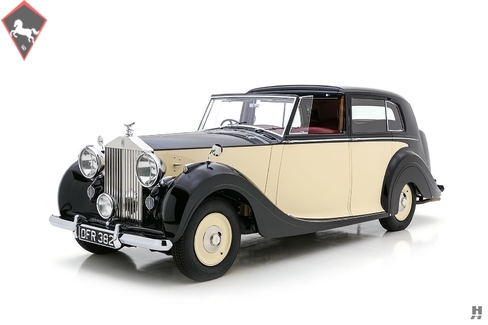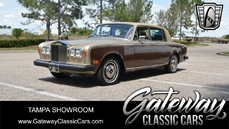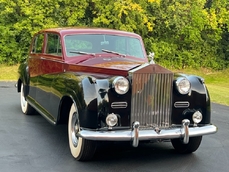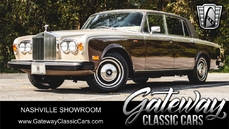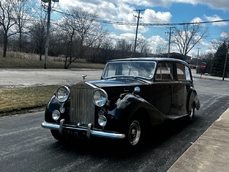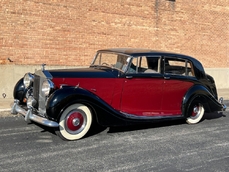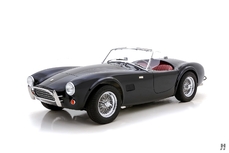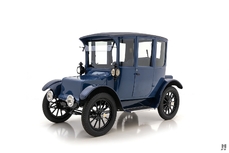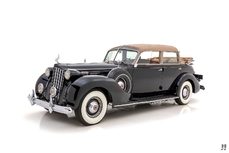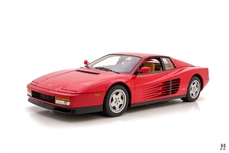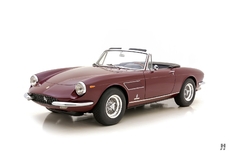Rolls-Royce Silver Wraith Sedanca DeVille 1947
General description :
Amidst the settling dust that marked the end of World War II, Rolls-Royce found itself at a crossroads. The company hadn’t built an automobile since 1940, as they directed all resources to the aero-engine plant in Crewe in support of the war effort. Some within the company felt it was not worth returning to motorcar production and that aero engines should become the number-one priority for the future. Thankfully, there were enough champions of Rolls-Royce motor cars within the ranks to convince the board otherwise, and soon an all-new model was on the drawing board.
The Silver Wraith became Rolls-Royce’s debut post-war offering, holding the distinction of being the first model built in the now-legendary Crewe factory. That facility already had an extensive machine shop and a full staff of skilled workers, making the transition from Merlin engine production to motorcar production relatively straightforward. The new Silver Wraith was, for all intents and purposes, a clean-sheet design for the modern era. It served as the standard offering, with only the ultra-exclusive, eight-cylinder Phantom IV (just 18 built) sitting above it. The Silver Wraith used the 4.25-liter inline six-cylinder engine, featuring an F-head design with overhead inlet valves and side-mounted exhaust valves. Keeping with Rolls-Royce tradition, the Silver Wraith was sold only as a rolling chassis, for delivery to outside coachbuilders. It was not until the Silver Dawn that Rolls adopted Standard Steel Saloon as pioneered by its mechanical twin, the Bentley Mk VI. Between 1946 and 1958, Rolls-Royce produced a total of 1,883 Silver Wraiths. Today’s enthusiasts cherish the Silver Wraith for the way it combines a classic pre-war aesthetic with refined, post-war performance.
With its elegant coachwork by H.J. Mulliner, chassis number WAB20 is a marvelous example of the stately and imposing Silver Wraith. This stunning Rolls-Royce comes with a large history file spanning its more than seven decades of ownership. Build records provided by the Rolls Royce Enthusiasts Club document the car’s history from the chassis’ completion in March of 1948, to its shipment to H.J. Mulliner coachbuilders. Mulliner records indicate the order was for style number 7055, the elegant Sedanca De Ville. Assigned body number 4909, this car features several individual touches, including an electrically operated division window, electric rear sunshade, drinks cabinet, and radio. Delivery took place in August 1948 via Loxham’s Garages, Ltd, with the first owner listed H. Kamiya Esq, of Lytham St Annes. Subsequent owners are well-documented via the chassis cards and history files, and it remained in the U.K. for much of its early life when, in 1972, it came to Canada. Owned by clothier Edward Chapman, Ltd, the Rolls-Royce often appeared on display in his famous Vancouver store. After many years with the Chapman family, it transferred to Mr. Robert Wadden, a dedicated marque enthusiast who served as the chair of the Rolls-Royce Owner’s Club, B.C. Region.
In Mr. Wadden’s hands, the car received an exhaustive, nut-and-bolt, photo-documented restoration spanning the better part of ten years and completed in 2002. The goal of the project was to make it a reliable long-distance tourer, as well as a high-scoring RROC show car. Handling the project was R.X. Autoworks of North Vancouver, a highly respected restoration shop with numerous awards at Pebble Beach, Villa d’Este, and the Monaco Concours. They painstakingly restored WAB20, finishing it in a gorgeous combination of Masons Black with tan body sides, over a striking red leather interior. Mr. Wadden eventually sold the car to a collector from New York State who continued to care for and fine-tune it for judged RROC events.
Most recently, WAB20 was part of a significant private collection, and it presents in outstanding condition, with a gently matured restoration that still looks ready for show or touring. The paintwork is superb, with gorgeous black wings and upper panels contrasting the cream-colored body sides and wheels. Panel fit is exemplary, with doors that operate with the quality expected of a coachbuilt Rolls-Royce. The chrome is in excellent order all around, with only some minor patina visible on the radiator shell. Styling is similar to the Mulliner Touring Limousine, except for the opening driver’s compartment, which lends the sharp, formal appearance. The separate headlamps and large center-mount Lucas fog lamp give the car a stately, pre-war character.
From new, this car featured tan broadcloth upholstery in the rear, with leather in front. For the restoration, Mr. Wadden chose striking red Connolly hides for the seats and interior panels. Other materials include West of England broadcloth headlining and Wilton wool carpets. All of the original woodwork was restored to a very high standard, using book-matched, edge-banded walnut veneer on the dash, door caps, and the impressive center division panel. The elaborate fittings are correct for this car, as noted on the H.J. Mulliner build sheets, including fold-down tray tables, fold-away footrests, flush cabinets housing a crystal decanter set, and the original radio. In addition to the superb soft trim, the electrical equipment is restored, including the electric rear blind, electric division window, radio, instruments, and trafficators.
The original, numbers-matching 4.25-liter inline-six received a complete overhaul as part of the restoration. The project included new bearings, valves, guides, resurfaced block, reground crank, and a rebuilt clutch and pressure plate. Factory-correct surfaces were restored, and hardware nickel plated as needed. The presentation remains excellent, with a slight character from use, but highly correct and to original specs. It has consistently scored high marks (and numerous trophies) in RROC concours events while also proving to be a reliable tour car.
Accompanying the car is the original under-dash tool kit, numerous ribbons and awards, and the history file documenting its restoration, service, and show participation through the years. We rarely encounter examples of the Silver Wraith restored to such a meticulous standard, and this superb motorcar is sure to satisfy the most discriminating collector, with its beautiful presentation and superb mechanical condition, it is ready to provide many pleasurable miles on the road.
Offers welcome and trades considered
https://hymanltd.com/vehicles/6568
1947 Rolls-Royce Silver Wraith Sedanca DeVille is listed sold on ClassicDigest in St. Louis by Mark Hyman for $92500.
Car Facts
Car type : Car Make : Rolls-Royce Model : Silver Wraith Model Version : Sedanca DeVille Engine size : 0.0 Model Year : 1947 Sub type : Sedan Location : Missouri
Sold
Seller Information
Sold
People who viewed this Rolls-Royce Silver Wraith also viewed similar Rolls-Royce listed at ClassicDigest
Other cars listed for sale by this dealer
About Rolls-Royce
Well, ladies and gentlemen, today we're diving into the illustrious history of a brand that has always embodied the very essence of British luxury and craftsmanship - Rolls-Royce.Our story begins at the turn of the 20th century when two visionaries, Charles Rolls and Henry Royce, decided to join forces. In 1904, the very first Rolls-Royce was born, the Rolls-Royce 10 hp. It was a modest start for a company that would go on to redefine automotive excellence.
But it wasn't until 1907 that Rolls-Royce truly made its mark with the introduction of the Silver Ghost. It was hailed as the "Best Car in the World" and set the gold standard for luxury motoring. With its whisper-quiet engine and exquisite craftsmanship, it was a statement of opulence and refinement.
The 1920s brought us the Rolls-Royce Phantom I, an icon of its time. It was the first Rolls-Royce to feature a 6-cylinder engine and set the stage for the legendary Phantom line. This was the era when the Maharajas of India commissioned custom-bodied Rolls-Royces that were nothing short of automotive palaces.
Fast forward to the post-war years, and we have the Silver Cloud, a symbol of post-war British optimism. The Silver Cloud was elegance personified, with its flowing lines and handcrafted interiors. It was the choice of royalty, celebrities, and captains of industry.
But if we're talking about the epitome of Rolls-Royce luxury, it's the Rolls-Royce Phantom VI, which graced us with its presence from 1968 to 1991. This was a car that made the statement that "if you have to ask the price, you can't afford it." Customization was the name of the game, and the Phantom VI was a canvas for the world's wealthiest to express their unique tastes.
Now, it's impossible to discuss Rolls-Royce without mentioning the Rolls-Royce Corniche. Produced from 1971 to 1995, it was a convertible and coupe version of the Silver Shadow. The Corniche was the quintessential grand tourer, a car for those who wished to traverse continents in absolute luxury.
But, alas, even the mightiest must face their decline, and Rolls-Royce was no exception. The company went through financial turmoil in the 1970s and 80s, leading to the takeover by Vickers plc. Then came the controversial BMW and Volkswagen ownership period, which divided enthusiasts.
Rolls-Royce regained its footing under BMW ownership, and the new millennium brought us the Rolls-Royce Phantom VII, a return to the company's roots of uncompromising luxury. The Phantom VII was a testament to British engineering and craftsmanship.
And that, ladies and gentlemen, brings us to today. Rolls-Royce continues to produce some of the most opulent, bespoke vehicles on the planet, a symbol of British imperiousness that has not waned with time. The spirit of Sir Henry Royce and Charles Rolls lives on in every car that bears the Spirit of Ecstasy, a testament to the enduring legacy of British automotive excellence.
